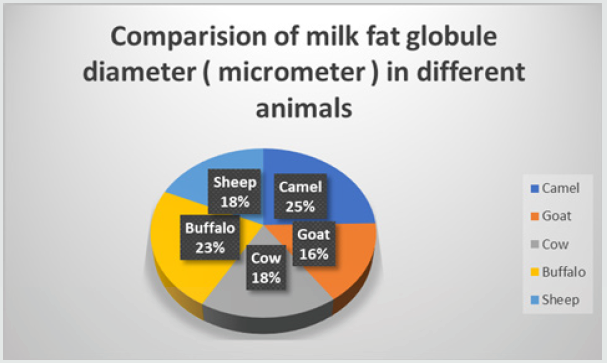Lupine Publishers | Journal of Dairy & Veterinary Sciences
Abstract
The camel is domesticated in various regions of Asia and Africa, it is considered as a friendly and harmless animal that can survive in hard environmental conditions and provides sources of income to its owners in form of milk, meat, and skin by-products. Camel milk is highly nutritive and possesses some unique characteristics which are being investigated nowadays by many researchers and surprising results revealed that it can be utilized as a natural cure for various life-threatening diseases. This work is aimed to review and highlight the importance of camel milk and its therapeutic properties.
Keywords: Camel; Milk; Health
Mini Review
The Camels also called ship of the desert is one of the most abundant type of animal present in mostly arid zones of Asia and Africa. Since ancient times camels have been domesticated for their products like skin, meat and milk [1]. Milk is the most valuable by product of camel, so it is called as “white gold of desert”. According to some researchers, the camel produces more milk than any other livestock species and its duration of milk production is also longer. The whole lactation periods are comprising of almost 12- 18 months and daily production of milk is almost 3-10kg. The milk of camel consists of a 30 % annual caloric intake of the pastoral community diet [2]. The camel milk is having sharp salty taste with pungent smell and appears as dark white in color. Its taste can vary slightly depending on breed, feeding, health status as well as amount of water consumption by camel. When compared to cow milk which retains its properties for just 2-3 days the camel milk retains its quality for up to 12 days when stored at 2 °C temperature. Moreover, it is also stable for 8-10 hrs. at room temperature. The pH of fresh camel milk is normally neutral but can be tasted slightly acidic if kept for longer period of time [3]. The camel milk has some unique physiological characters like the fat globule diameter is also bigger than that of cow, goat, sheep milk (Figure 1).
Camel milk is very much healthy and is consumed in many regions of the world to cure some diseases as well [4]. It contains many vitamins and also higher amount of zinc so it plays a major role in immune system of body as cells of immune system are sensitive to zinc deficiency [5]. Moreover, some studies have revealed that camel milk also possesses insulin-like properties and can control blood sugar due to hypoglycemic properties in diabetic patients. It can be used as a natural medicine for diabetic patients. Along with that properties this miraculous milk has been also proved by many scientists as a natural medicine for autism and some food allergies [6]. Camel milk naturally consists low lactose as compared to cow milk so according to research, it was suggested that camel milk can be utilized by patients having lactose intolerance issues [7]. An animal study carried out in 2010 revealed that fermented camel milk possess increased number of electrolytes including sodium and potassium and it has therapeutic effects on diarrhea in rats. Thus, it can be decided that fermented camel milk can be consumed food for improving nutritive status of the body and also as therapeutic applications [8]. Naturally camel milk has various enzymes that have immunological as well as antibacterial properties and contains varieties of bacteriocins as shown in Table 1. The main enzyme is lysozyme which attacks common invading pathogens by developing primary immune system of the body. Camel milk is naturally rich in this enzyme. Moreover, it possesses natural lactoferrin which prevents microbial growth within the body and kills germs. The concentration of lactoferrin is much more in camel milk as compared to cow, sheep and goat milk [9].
The Lacto-peroxidase enzyme has negative effects on tumor growth and is associated with the iodination of thyroid hormones by acting on thyroid peroxidase enzymes they are naturally present in camel milk. The highest concentration of these enzymes is also having impacts on suppressing metastasis of breast cancer cells [10]. A previous study has revealed that camel milk has effect on oxidative stress in autistic children by increasing the concentration of some antioxidant enzymes like glutathione peroxidase, superoxide dismutase along with myeloperoxidase enzyme when they consumed camel milk for two weeks the levels of these antioxidant enzymes were significantly increased as well as autistic behavior was also improved [11]. More experiments were conducted to evaluate the therapeutics properties of Camel milk in some case reports, invitro as well as in vivo experiments and in some clinical trials also. These studies suggest that camel milk can be utilized to cardiovascular diseases, tuberculosis, hepatitis, autoimmune disorders, rickets and liver cirrhosis [12-16] Although various reviews have been done on properties of milk of different domestic animals the camel milk properties are still lacking till now. Thus, this paper is designed to review accessible evidence on the dietary as well as medicinal worth of camel milk and indorse further study regarding the nutritional and medicinal worth of camel milk built on the data from this literature review.
Conclusion
Camel milk is consisting of important nutrients that are required to keep the body healthy. It contains adequate ratio of antibacterial and antifungal agents that are useful for the prevention of various diseases, like diabetic, cancer, cardiovascular diseases, autism, Rota virus diarrhea, lactose intolerance, autoimmune disorders. It is miraculous milk but lacks plenty of research on its qualities, therefore many people are still unaware of its qualities. Thus, further research should be done at molecular levels to evaluate its qualities and impacts on health.
Read More About Lupine Publishers | Journal of Dairy & Veterinary Sciences Please Click on Below Link:
https://lupine-publishers-dairy-veterinary.blogspot.com/



No comments:
Post a Comment
Note: only a member of this blog may post a comment.